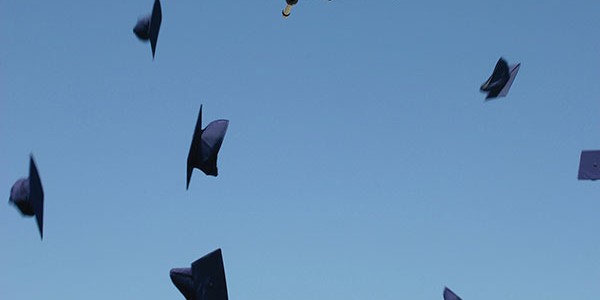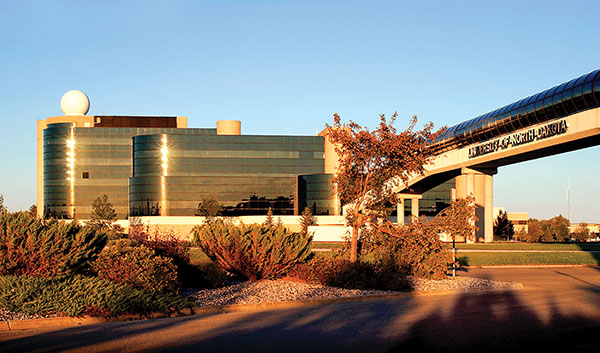When does a community of enthusiasts and innovators become an industry? In the case of commercial unmanned aircraft in the United States and all of its potential applications, it is a question for academics and historians to take up years from now. When scholars assemble and analyze the chronology of events and milestones that formed whatever it is they’ll be calling the UAV sector represented by RotorDrone and its readers today, they will all likely agree that the demand by entrepreneurs and established businesses to take their commercial UAV ideas to market far exceeded their ability to do so in 2014. But if you could quantify the buzz about UAVs on college campuses across the county, you might agree that the seeds for this industry were planted years ago.
Next year, when the Federal Aviation Administration is expected to produce a set of regulations for a meaningful commercial UAV environment, a new wave of business activity is expected in the United States. A monstrous wave. Today, there is only a market waiting to be defined: a pent-up demand to commercialize winged and rotor-based flying machines and the compelling services that they can enable. Certainly, many of tomorrow’s UAV leaders are getting their start today, well before the expected gold rush begins. The Association for Unmanned Vehicle Systems International believes that the three years following the successful integration of unmanned aircraft into U.S. airspace will produce an economic impact of more than $13.6 billion, with 70,000 jobs being created. By 2025, they think the economic impact could be as high as $82 billion! While the hype cycle in many (if not most) emerging markets often leads to mountainous growth projections, we can all agree that the potential is great.
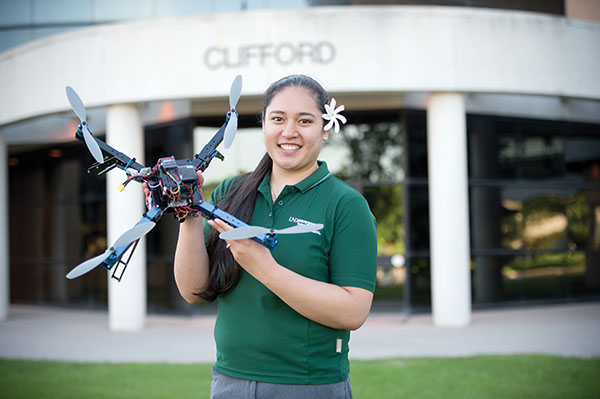
Above: Students design their own rotor-based UAVs as a part of the University of North Dakota’s degree program and will ultimately be trained to fly both manned and unmanned aircraft.
Tomorrow’s leaders are getting their start in the places that you would expect. The hobbyist community has helped to drive innovation since the early days of model airplanes, but the inertia created by affordable (and advanced) consumer rotorcraft and radios, the rise of high-definition action sports cameras and the once-unimaginable ease of video distribution via YouTube does more to swell the number of self-educated enthusiasts than any ad campaign could ever hope to.
Educational opportunities
The word “drone” sometimes carries a burden of association with seemingly sinister government or military intent by many who aren’t recognizing the commercial benefits on the horizon. These attitudes are sure to change, especially as military and government innovators bring their expertise to the private sector. There is no doubt that the two and a half decades following the FAA’s first authorized use of unmanned aircraft in the National Airspace System has led to a pool of leading thinkers from the government and their technology partners and contractors. They have been working in highly controlled environments up until now: to improve border and port security, spur scientific study and environmental monitoring, drive university research programs and support public safety. The U.S. Air Force must also be seeing a rise of interest from those hoping to follow the Sensor Operator career path and receive advanced technical education to support unmanned aircraft initiatives from the Air Education and Training Command centers at Randolph Air Force Base and Lackland Air Force Base in San Antonio, TX .
Embry-Riddle Aeronautical University, the only fully accredited, aviation-oriented university in the world, has been supplying well-qualified graduates to the aviation and aerospace sectors since 1925. It should come as no surprise that the school now offers a Bachelor of Science in Unmanned Aircraft Systems Science degree from its Department of Aeronautical Science (in the College of Aviation). The school also offers a Master of Science degree in Unmanned & Autonomous Systems Engineering, which further pilots coursework into segments for automobile, marine vessels and spacecraft applications.
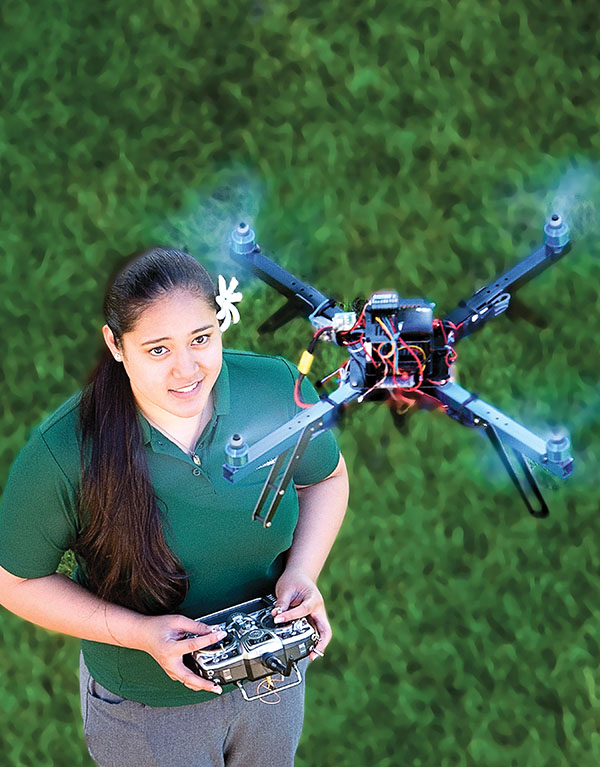
Above: NDU degree candidates are offered a solid systems background that will enable them to bridge the gap between engineer and operator.
It won’t be long before more academic leaders fully embrace the potential of the UAV market across the full spectrum of their academic disciplines. Think about it: every engineering school must have students who would normally be fixated on robots and mechanical automation now turning their attention to rotor-driven aircraft for school projects. Some football teams are even recording practices and team drills from above to add perspective to their video review sessions. Agriculture schools in particular know that they need to infuse their curricula with a practical UAV knowledge-base to train tomorrow’s food producers.
Large scale operations will be highly dependent upon specialized drones and rotorcraft. The next-generation disciplines of “precision agriculture” and site-specific crop management promise huge gains for the industry, much of it derived from aerial data and imagery.
What would Everett M. Rogers think of all this? The son of a farmer himself, he published his often-cited “Diffusion of Innovations” theory back in 1962, and it has since been reworked and revised to help explain all types of challenges associated with an innovation’s crossover to the mass market. In the simplest terms, he defined several classes of consumer (whether individual or organization), represented by their willingness and ability to embrace new technology as a percentage within the entire population. Innovators (at 2.5% of the population), were followed by Early Adopters (13.5%), Early Majority (34%), Late Majority (34%) and Laggards (16%). A specialist in rural sociology, he studied how social and environmental factors could influence these populations of individual adopters as they integrated new technologies into their lives and businesses and eventually (sometimes very slowly) create a self-sustaining market. It seems as though the missing link of a commercial UAV regulatory environment for U.S. innovation to proceed at a natural pace might result in applications being adopted at a very rapid rate once the gates are finally opened.
University of North Dakota
In 2007, the University of North Dakota’s Ben Trapnell came up with a list of more than 90 potential uses for non-military, commercial UAVs. He is the Associate Professor of Aeronautics (UAS Operations) within the John D. Odegard School of Aerospace Sciences at the university, and his initial market research helped to define what would become the first unmanned aircraft degree program. Today, there are over 130 students who are pursuing a B.S. in Aeronautics with a major in Unmanned Aircraft Systems Operations at the school in Grand Forks, ND. Prior to launching the UND program, he attended many of the military-oriented conferences focused on UAV technology with his colleagues. The engineering community became more outspoken at some of these events as they were developing UAVs but were unsure about why they were restricted from flying them commercially. “They had no clue about the regulatory, safety, environmental and operational environment,” he says.
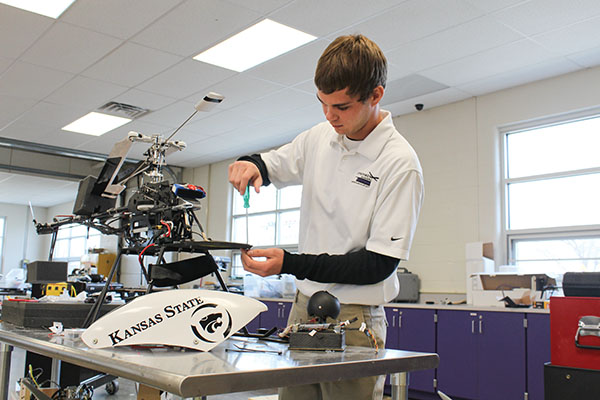
Above: Kansas State University Salina’s program was developed to be operator-focused, but graduates will be prepared for all of the challenges of integrating UAVs into the National Airspace System.
A graduate of the United States Naval Academy, with a Master of Aeronautical Science degree from Embry-Riddle Aeronautical University among his credentials, Trapnell has seen the first wave of students who entered the UND program become sought-after graduates who are actively employed at leading-edge companies like General Atomics, Textron, Boeing, Navmar Applied Sciences Corporation, Bosch, VT Group and at a number of overseas operators in countries where the regulatory environment has already been defined. With 25 years of experience at the University of North Dakota and 45 years of unmanned aircraft background as both a researcher and enthusiast, his colleagues saw him as a natural to help lead the development of this first-of-its-kind, fully accredited degree program.
He likes to see students have the opportunity to “tap into their passion” but is quick to acknowledge the contribution of hobbyists in helping to define the industry as many of today’s advances in consumer rotorcraft have been created by amateurs. “People look at their hobby and wish it was a job,” he says. In fact, every student builds their own rotordrone during their time in the program, using products from 3D Robotics as a platform. “I like what they are doing,” he says of the California-based company. “3D Robotics is going to be a disruptive entity.” Of course, students also have access to the resources of a public institution that has been at the forefront of research in the unmanned aircraft sector through partnerships and grants from leading private sector organizations and government agencies. Their Center of Excellence for UAS Research, Education, and Training is just another example of how the university has recognized the multi-disciplinary elements of the sector and dialed in the expertise of those who can help to shape the non-technical privacy concerns and social implications as the market develops.
“As well as the technology itself, one of the best things that we can do is give our students a solid background in the operational, regulatory, and safety environment— the National Airspace System — that they will work in,” he says. “They need a strong systems background. We want students to be hireable in both the manned and unmanned market.”
Indeed. Not only is the degree program a natural fit within the John D. Odegard School of Aerospace Sciences, it is an aviation degree. All students complete coursework for their commercial multi-engine and instrument certification. Some even go on to earn flight instruction certification which should make them even more desirable to employers seeking to train the next generation of contributors.
University of North Dakota students seeking a degree in unmanned aircraft systems operations are going to be faced with coursework that touches on all of the elements of both manned and unmanned aviation: air traffic control, aviation safety, human factors, flight
physiology, aerodynamics, aircraft systems, multi-engine systems, gas turbine engines, aerospace law, international and long-range navigation, crew resource management, and meteorology, in addition to th
e UAS-specific material.
AVIT 226: Introduction to UAS Operations
This course of instruction introduces the student to the history of Unmanned Aircraft Systems and their current and future development for use in a burgeoning civil industry. Specific blocks deal with aircraft, ground, communications, launch and recovery systems while emphasizing the human integration into the overall system.
AVIT 331: Unmanned Aircraft Systems
This course of instruction introduces the student to the systems common to most Unmanned Aircraft with focus on those that differ significantly from their manned counterparts. Specific emphasis is placed upon autopilot systems and their integration with flight controls and airborne communications systems.
AVIT 332: UAS Ground SystemsThis course introduces the student to those subsystems that comprise the unmanned aircraft system (UAS) ground control and mission planning system. The launch and recovery systems typical of current UAS are also covered.
AVIT 333: UAS Remote Sensing
This course presents the theory and operations of common sensors used by the operators of unmanned aircraft systems. Theory is combined with operational scenarios in order to provide the student with the ability to match specific sensors with anticipated missions
AVIT 334: UAS Communications and Telemetry Systems
This course introduces the student to control and sensor data link communications technology. Theory, combined with real-world examples, will allow the student to understand normal and degraded operations of UAS communications and telemetry data link systems.
AVIT 338: UAS Operations
This course of instruction will develop the student’s knowledge and skills that are needed to safely employ unmanned aircraft systems. Course content includes aircraft operating software, launch and recovery operations, payload operations, normal and emergency procedures, and mission planning and execution. Specific emphasis will be placed upon aircraft and payload selection based upon proposed mission analysis. Students must complete the appropriate flight lessons to satisfactorily complete the course.
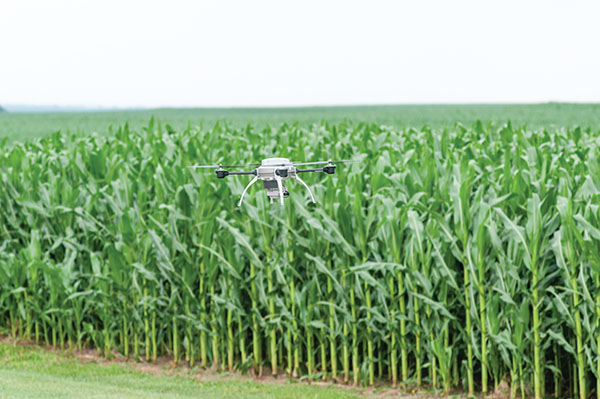
Above: Students at Kansas State University Salina benefit from a unique set of UAV resources, not the least of which is the school’s wealth of access to restricted airspace.
Kansas State University Salina
At the Salina, KS, campus of Kansas State University, you will find another American degree program that serves as a milestone in the emergence of the commercial UAS sector. “The second degree on the books,” as UAS Program Manager Mark Blanks calls it. He joined the Applied Aviation Research Center at K-State after building a curriculum at Middle Tennessee State University, where he also earned a B.S. degree in Aerospace Maintenance Management before completing an M.S. degree in Aviation Systems from the University of Tennessee Space Institute. He was recruited to K-State by Dr. Kurt Barnhart, professor and head of the Aviation Department at Kansas State University, who also serves as the executive director of the Applied Aviation Research Center there.
K-State Salina is fortunate to have access to restricted airspace at the nearby Smoky Hills Weapons Range, which offers students a level of hands-on flight experience with a wide variety of rotor-based and winged aircraft that would be hard to match elsewhere. In fact, students participate in the approximately 100 flight training missions that the university completes each year.
Blanks calls the coursework for the Bachelor of Science in Aeronautical Technology with an Unmanned Aircraft Systems option an “operator-focused” curriculum that is supplemented by the university’s restricted airspace access to offer students a unique combination of academic coursework and live flight experience.
With an advanced fleet that represents the wide variety of single rotor, multirotor and single-wing technologies that will need to be integrated into the National Airspace System by tomorrow’s UAS leaders, Blanks also counts DJI Phantoms and S800s among the program’s aircraft. “They are great for research,” he says.
Training with open source software, sensors and innovative third party technology such as Cloud Cap Technology’s Piccolo autopilot solutions gives students a practical advantage that they can take with them into the field. More real-world training opportunities for the more than 40 degree candidates (some with double majors) exist at the Crisis City facility operated by the Kansas Division of Emergency Management. Only 8 miles southwest of the campus, the facility hosts multiple training venues to enhance the state’s ability to defend against terrorism threats and respond to disasters and emergencies.
K-State Salina degree candidates will get a dose of private pilot and instrumentation coursework in their freshman years to be balanced with plane trigonometry and electronics courses. In addition to business-focused coursework on leadership, marketing, macroeconomics and technical writing, students will take classes in composites, physics, human factors in aviation, aerodynamics and semiconductor classes during their second and third years, in addition to the UAS-specific material.
Just the beginning
These two universities will be recognized for taking the first steps by U.S. public universities to provide comprehensive degree programs for the next generation of contributors to the commercial UAV revolution. There will need to be many more. From the military. From community colleges. From private educational institutions. And from other universities that can leverage their unique strengths, geographies and talent pools to host programs that will inspire students, faculty and staff who wish to play a leading role in shaping the dozens of UAS-driven applications that we are likely to see in the near future.
By Tim Bresien Photos Courtesy of the University of North Dakota & Kansas State University Salina


